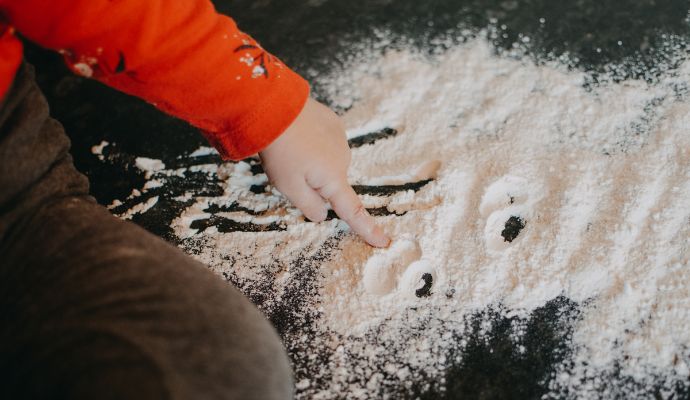
Babies and toddlers use their senses to explore and make sense of the world around them. By engaging their senses, babies are able to learn and retain information as well as develop new connections in their brain.
Sensory play involves activities which stimulate little one’s senses as they explore and play. This builds nerve connections in the brain’s pathways, allowing your baby or toddler to understand more complex learning tasks, refining their motor skills and problem-solving skills. Sensory play lets your baby explore the world, and can be a great way for you and your little one to bond!
You can start sensory play when your baby is about 4-6 months old, and it can continue well into their toddlerhood. Always supervise your baby as they play with the activity you put together!
Rice exploration
Materials: rice, tray or storage bin, toys
Pour uncooked rice into your tray or storage bin along with toys. Dry rice is easier to clean up if it gets everywhere, compared to dirt or sand. Your little one will be fascinated with the sensation of dry rice on their fingers, as they sift through it. By adding some small sized-toys into the mix, your baby will get to dig and uncover them!
To add to the excitement, consider adding new toys into the bin. It’s up to you how much rice you want to spare for this activity. You can draw shapes or letters in the tray of rice and let your baby do the same.
Optional: Give your little one a spoon so they can scoop and spread rice around the tray. If you decide to give your baby a spoon, be careful of not letting him eat the uncooked rice!

Finger “Paint”
Materials: Whipped cream
Messy play gets your baby used to experiencing different sensations. Spread the whipped cream on the highchair table. Your little one can paint and make small movements with their fingers with the whipped cream! The great thing about whipped cream there’s no need to panic if your baby starts to put fingers in his mouth, which he may end up doing.
Just like the rice exploration project, you can even join in with your little one and draw shapes, lines, or the letters in their name.
Sensory bag
Sensory bags, also known as squish bags, can get messy, but we’ll show you how your little one can play without any messes. Sensory play impacts many areas of development. Your little one will develop fine motor skills through manipulating the objects in the sensory bag. You can introduce sensory bags to your baby at 6 months. At this age, they can use their hands to reach and touch!
When your little one plays with sensory bags, they may also learn social skills by communicating their experiences and sharing it with others. That could be you and your partner, or any siblings and friends!
Materials: resealable plastic bag, tape, water or hair gel, frozen peas
Fill the bag with frozen peas and add a little bit of water or gel. Seal the bag and tape it down on all sides to your surface, so it doesn’t move. As your baby pokes and squishes the bag, they learn about cause-and-effect.
There is no right or wrong way to create a sensory bag! You can use rice, sprinkles, buttons, or even ice. Your curious baby will learn so much, and have fun at the same time. You won’t need to put water into the sensory bag if you’re extra cautious about making a mess, but it helps little objects move around easily. Inexpensive suggestions for your sensory bag include pom poms, plastic letters, rice, leaves., beans, marbles, or play dough.
Always supervise your baby as they play with a sensory bag.

Cotton balls
This simple sensory play lets your little one play with different textures!
Materials: cotton balls, towel, tray or bowl, water
Lay a towel on the area where your baby will play to reduce any messes. Fill your container with a little water and add plenty of cotton balls. Your baby will learn about the texture of cotton balls, and how it sticks together and comes apart when it’s dry. They’ll also explore how cotton balls absorb water, and how water comes out when they squeeze it!
Optional: Instead of adding water, add toys! Let your little one move the cotton balls around and find out what’s hiding in the container.
If your baby starts to cry or shows disinterest in these sensory play projects, that’s totally okay! Even if you’re eager to introduce different textures and sensations, you don’t need to pressure your baby.
What we love about sensory play projects is that there isn’t a right or wrong way to make one – it depends on how elaborate you want it to be. You can go out and buy materials, or you can use safe materials you have at home.
Resources:


















Leave a comment